Our Mecklenburg tour ended about a week ago and I think I can say it was successful, although we had our worries. This was a tough place for finding contacts. First off, Mecklenburg is a beautiful area, I keep calling it “big sky country” lots of open fields and wide expanses of sky. Lucky for us they were mostly blue with white fluffy clouds. But this “big sky country” feels very remote, has extremely small villages and you can still see the remnants of their 40+ years of GDR occupation with lots of large, gray cement block apartment houses and roads that could use some help.
What I was most surprised with was the brick church in each little village, even some of the smallest villages had t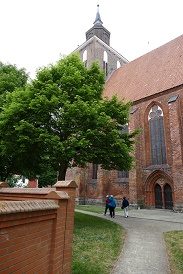 heir own church. Brick gothic is the characteristic architectural style in many cities along the coast of the Baltic Sea and throughout the regions surrounding it. Every piece of red brick comprising the buildings was made by hand and every single building is a masterpiece. These
heir own church. Brick gothic is the characteristic architectural style in many cities along the coast of the Baltic Sea and throughout the regions surrounding it. Every piece of red brick comprising the buildings was made by hand and every single building is a masterpiece. These 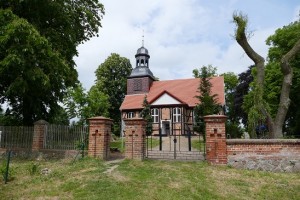 churches ranged from small to very large, very modest and poor inside to very ornate and the architecture was amazing. How did they build these magnificent buildings in the 1100’s?
churches ranged from small to very large, very modest and poor inside to very ornate and the architecture was amazing. How did they build these magnificent buildings in the 1100’s?
Another thing that I have found in my experience visiting churches in the East vs in the west of Germany, that a lot of the East churches will have the main entrance on the side. You walk in the middle with the altar and some pews to the right of you and more pews to the left. Also in Mecklenburg-Vorpommern in the front of the church will be a separate section of pews for the “ruling noble family” (more on this in next paragraph). I learned also that the pulpit, which the pastor would use for giving a sermon, may have a covering over the top, which was used as a sounding board, so sound would carry (before microphone days).
 A couple other observations about the churches in this area, that I personally haven’t seen in other areas of Germany, the church bell is in the church yard not in the steeple (or a combo of the two). There is a structure built in the front of the church holding the church bell. We had one of our tour members ring the bell of her ancestral church.
A couple other observations about the churches in this area, that I personally haven’t seen in other areas of Germany, the church bell is in the church yard not in the steeple (or a combo of the two). There is a structure built in the front of the church holding the church bell. We had one of our tour members ring the bell of her ancestral church.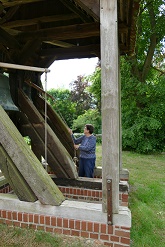
Also, most of the cemeteries are still surrounding the church. In the west they of course, used to be surrounding the church but for many years have been moved near the church or down the street. In these cemeteries we also saw something we rarely see, a sectioned off portion that were the graves of the ruling noble family and these could be old graves, which you don’t normally see (unless they are prominent people).
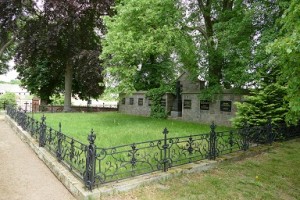
The other big surprising thing that was new to me was how the Gut system worked in this area of Germany. A Gut was usually a Landlord (land owner’s) estate and could encompass a lot of land. The tenant farmers could occupy small farms or day laborer’s cottages across the property but in this Mecklenburg – Vorpommern area the Gut would contain the Manor house, the cow and horse stables, a granary and the living quarters for the tenant farmers, almost like a small village in itself. We learned that the tenant farmers would be provided this place to live, have a small garden for themselves and earn a little money, but not enough to make it possible to own their own property. What was most surprising to me though was, you could go 2 km down the road and the next village had their own noble family Gut, church and cemetery. I would have thought that they would have been further apart. After the trip Matthias and I were exploring the Schleswig-Holstein area and stayed at a Gut Estate which was still intact but turned into a hotel, conference center, wedding venue now. Absolutely gorgeous and still occupied by the Count and Countess. Countess zu Rantzau gave us a private tour through the whole compound and sat down with us to answer some questions. I highly recommend Gut Pronstorf if you are in the Holstein area. (click on picture to see a good example of how Gut was set up)
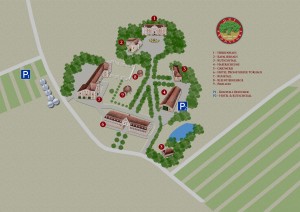
Our tour members all had good hometown visits and hopefully if they read this they could leave a comment below on their visit but on one day we took one of our ladies to a couple of her hometowns and we visited several churches, the second one we were met by a lady pastor who was very informative, she told us how for most pastors in this area they have to serve at least 4, 5 or more churches, so services are not held at every parish every week, maybe once a month or so. This second little church we toured was very poor, the pastor told us how life would have been like for them in days past. While we were standing there, Susan, whose hometown this was said “Did you feel that?” and I said yes, because a feeling had come over both of us that we knew what her ancestors must have felt. they were so poor and not any opportunity to have a better life that they had to leave. It was kind of a feeling of sadness mixed with a little bit of hope. I would hope they know that their descendants did get that better life.
